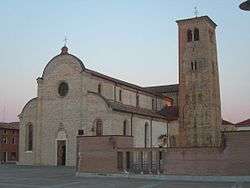Concordia Sagittaria
| Concordia Sagittaria | ||
|---|---|---|
| Comune | ||
| Comune di Concordia Sagittaria | ||
|
Cathedral of Concordia Sagittaria. | ||
| ||
 Concordia Sagittaria Location of Concordia Sagittaria in Italy | ||
| Coordinates: 45°46′N 12°51′E / 45.767°N 12.850°E | ||
| Country | Italy | |
| Region | Veneto | |
| Province / Metropolitan city | Venice (VE) | |
| Frazioni | Cavanella, Paludetto, Sindacale, Teson | |
| Government | ||
| • Mayor | Marco Geromin | |
| Area | ||
| • Total | 66.50 km2 (25.68 sq mi) | |
| Elevation | 4 m (13 ft) | |
| Population (28 February 2007) | ||
| • Total | 10,708 | |
| • Density | 160/km2 (420/sq mi) | |
| Demonym(s) | Concordiesi | |
| Time zone | CET (UTC+1) | |
| • Summer (DST) | CEST (UTC+2) | |
| Postal code | 30023 | |
| Dialing code | 0421 | |
| Website | Official website | |
Concordia Sagittaria is a town and comune in the province of Venezia, Veneto, Italy.
History
The town was founded in 42 BC as Iulia Concordia by the Romans, where the Via Annia and the Via Postumia crossed each other. It was taken and destroyed by Attila in 452 AD.[1]
After the fall of the Western Roman Empire it was part of the Lombard duchy of Cividale, and later was first in the March of Friuli and then in the Patriarchate of Aquileia.
In 1420, together with all Friuli, it was annexed by the Republic of Venice.
In 1838 it was separated from Friuli to be included in the province of Venice.
Main sights
- Trichora Martyrium (350 AD)
- Remains of the Roman Bridge (1st–2nd century AD)
- Bishop's Palace (15th century)
- Baptistery (11th century)
- Cathedral of St. Stephen (1466)
References
- ↑
 Chisholm, Hugh, ed. (1911). "Concordia (town)". Encyclopædia Britannica. 6 (11th ed.). Cambridge University Press. pp. 834–835.
Chisholm, Hugh, ed. (1911). "Concordia (town)". Encyclopædia Britannica. 6 (11th ed.). Cambridge University Press. pp. 834–835.
This article is issued from
Wikipedia.
The text is licensed under Creative Commons - Attribution - Sharealike.
Additional terms may apply for the media files.

